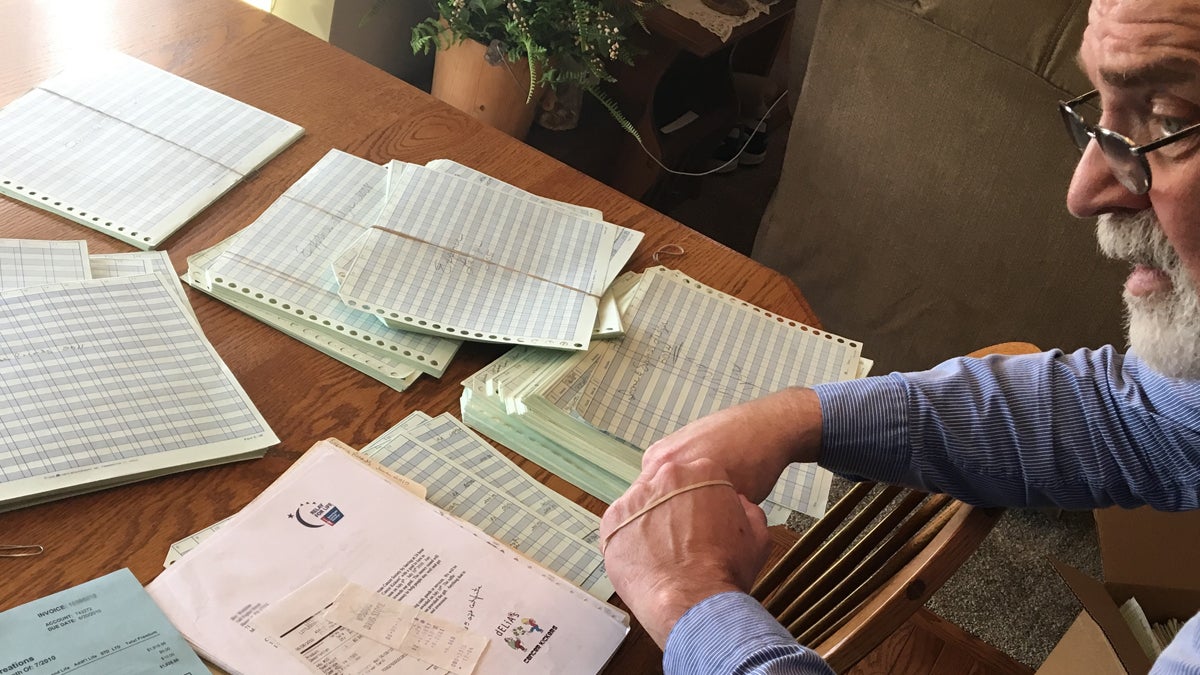Lessons from before the ACA: Dubious efforts in Pa., N.J. to cover pre-existing conditions
Listen
Carl Goulden of Littlestown Pa. developed a preexisting condition 10 years ago: hepatitis B. With a health plan on the self-employed individual insurance market, he says he then experienced annual rate increases he couldn’t keep up with, dropping the coverage and later joining Pennsylvania’s temporary high risk pool, set up as a transition to the launch of the Affordable Care Act’s marketplace. (Elana Gordon/WHYY)
Even with the GOP’s replacement for the Affordable Care Act tabled in Congress, people on both sides of the aisle emphasize the importance of covering people with pre-existing conditions.
But if leaders get rid of the ACA — or change it — exactly how will that coverage work?
A look at some recent history in Pennsylvania and New Jersey might offer insight into just how tricky the issue is.
Pennsylvania: The wild, wild West (sort of)
Before the ACA, states had differing approaches to handling pre-existing conditions in the small, individual and self-employed health insurance market.
Pennsylvania was typical. Before the ACA mandated that insurers cover people regardless of their health status and that they couldn’t charge them more, the market in the state was sort of the wild, wild West when it came to coverage.
“You may just have been out of luck,” said Teresa Miller, commissioner of insurance in Pennsylvania.
Insurers couldn’t overtly kick people off a plan if they got sick, but they could find ways to charge them a lot more — even those with less serious conditions. Miller said insurers often factored in gender, too.
For individuals looking to sign up in the first place, “an insurance company could simply decline to offer you insurance at all because of your pre–existing condition.”
The state insurance department received lots of complaints about this from people whose health conditions made it difficult to get coverage. Insurers who did offer something might have done so with a catch — the plans would often exclude treatment for that pre-existing condition, Miller said.
“So, let’s say you had diabetes, for example. You might have been able to get coverage for maybe an unexpected health care need that arose, but you’d still be on your own for any treatment and management of your diabetes,” Miller said.
The state did have one designated insurer in each region who guaranteed coverage to anyone who applied. They were called “the insurer of last resort.” In the Philadelphia region, that was Independence Blue Cross. Still, Miller said, those plans often came with those same catches.
“They could essentially include the individual’s medical history in rating those plans. So, in many cases, those plans would have been cost prohibitive,” Miller said. “Additionally, insurers of last resort could employ pre-existing-condition exclusions. So in Pennsylvania, typically, we saw a five year pre-existing-condition exclusions in the individual market.”
From the insurance company perspective, waiting periods for covering pre-existing conditions were intended to prevent the sick from signing up only when they needed costly care. Additionally, the underwriting and coverage denials were built into their whole business model. If they didn’t target coverage at healthier people, then they might wind up with a pool of too many people with costly health care needs.
Pennsylvania did try one other thing. It created a more scaled-back health plan, called Adult Basic, for those with lower incomes who didn’t have any coverage. Lots of people signed up, but the plans didn’t include cover mental health care, prescription drugs or more than two nights in a hospital. Even so, Miller said, it proved too expensive for the state.
“That program was spending $13 million to $14 million a month when it was shut down,” she said.
One small detour: High-risk pools
More than 30 other states dealt with pre-existing conditions by setting up so called “high-risk pools,” a separate program for individuals who couldn’t get coverage in the private market.
These could be real life-savers for some people with conditions like cancer, in which care could cost tens if not hundreds of thousands of dollars.
John Bertko, an insurance actuary with the state of California, said the experiences varied, but states faced lots of challenges — mainly the high cost.
“The one in California, which I was associated with, limited annual services to no more than $75,000, and they had a waiting list. There was not enough money,” he said. “So the 20,000 people who got into it were the lucky ones. At one point in time, there were another 10,000 people on a waiting list.”
The pools also had catches; premiums were expensive, as were out of pocket costs, and plans often had pre-existing condition coverage exclusions for six months to a year.
High-risk pools were also part of the ACA’s transition program into the new individual insurance marketplaces. The federal government set aside $5 billion for them, with the intent that it could keep them afloat until the 2014 launch of the marketplaces. Premiums weren’t as high, but Pennsylvania, like other states, experienced major snags, mainly that 1,000 more people signed up than anticipated — totaling 6,900 — and the $160 million in federal funds wasn’t enough to keep it going.
New Jersey: Pre-existing conditions covered (with a catch)
Across the Delaware River, meanwhile, New Jersey tried something else.
“Insurers could not take health status into account,” said Joel Cantor, director of Rutgers University’s Center for Health Policy who has been analyzing the New Jersey experience.
Before the ACA, New Jersey was one of just a handful of states that prohibited insurers from denying people with pre-existing conditions coverage. Insurers also couldn’t charge people a whole lot more for having a health issue, and the plans had to offer good coverage of services.
One caveat: There was a one year waiting period for cover a pre-existing condition. And cost was a bigger catch. The entire individual market in New Jersey became expensive for everyone, Cantor said, regardless of their health status. Because coverage was voluntary, people just didn’t sign up.
And so “the prices went up and up — the premiums — and enrollment when down and down,” he said.
The state tried to address this in the early 2000s by introducing a very “skinny” health plan.
“By that I mean very few benefits,” Cantor said. “It covered very, very limited services.”
In an interesting twist to traditional insurance — where once a person pays out a certain amount of money in care, the insurance kicks in and covers the rest — this type of insurance only covered a few hundred dollars in care. It was affordable and really popular, especially among the young and healthy people. Cantor said about 100,000 people signed up.
But if something did happen, or if a person had a chronic health need, lots of the costs shifted to the individual.
“It left people with huge financial exposure,” he said.
The ACA is a complicated story, Cantor said, but he thinks these pre-ACA experiences are criticalto understanding the current health care dilemma.
One aspect is a small portion of people consume a big chunk of health care costs, and it’s hard to predict who will wind up in that situation. So then one challenge becomes, how do you keep that coverage? How do you pay for it? And who shoulders that cost?
WHYY is your source for fact-based, in-depth journalism and information. As a nonprofit organization, we rely on financial support from readers like you. Please give today.

